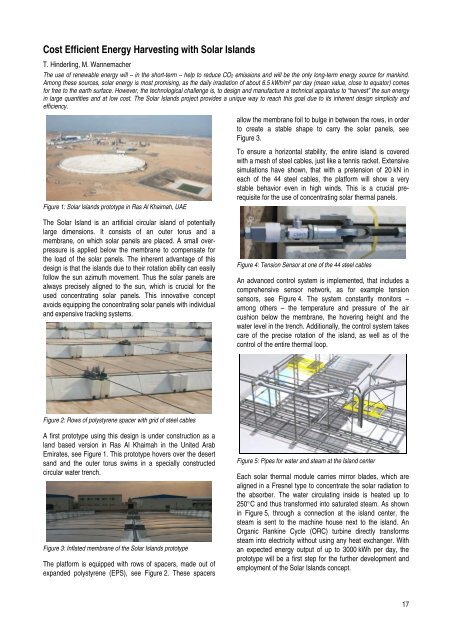CSEM Scientific and Technical Report 2008
CSEM Scientific and Technical Report 2008
CSEM Scientific and Technical Report 2008
You also want an ePaper? Increase the reach of your titles
YUMPU automatically turns print PDFs into web optimized ePapers that Google loves.
Cost Efficient Energy Harvesting with Solar Isl<strong>and</strong>s<br />
T. Hinderling, M. Wannemacher<br />
The use of renewable energy will – in the short-term – help to reduce CO2 emissions <strong>and</strong> will be the only long-term energy source for mankind.<br />
Among these sources, solar energy is most promising, as the daily irradiation of about 6.5 kWh/m 2 per day (mean value, close to equator) comes<br />
for free to the earth surface. However, the technological challenge is, to design <strong>and</strong> manufacture a technical apparatus to “harvest” the sun energy<br />
in large quantities <strong>and</strong> at low cost. The Solar Isl<strong>and</strong>s project provides a unique way to reach this goal due to its inherent design simplicity <strong>and</strong><br />
efficiency.<br />
Figure 1: Solar Isl<strong>and</strong>s prototype in Ras Al Khaimah, UAE<br />
The Solar Isl<strong>and</strong> is an artificial circular isl<strong>and</strong> of potentially<br />
large dimensions. It consists of an outer torus <strong>and</strong> a<br />
membrane, on which solar panels are placed. A small overpressure<br />
is applied below the membrane to compensate for<br />
the load of the solar panels. The inherent advantage of this<br />
design is that the isl<strong>and</strong>s due to their rotation ability can easily<br />
follow the sun azimuth movement. Thus the solar panels are<br />
always precisely aligned to the sun, which is crucial for the<br />
used concentrating solar panels. This innovative concept<br />
avoids equipping the concentrating solar panels with individual<br />
<strong>and</strong> expensive tracking systems.<br />
Figure 2: Rows of polystyrene spacer with grid of steel cables<br />
A first prototype using this design is under construction as a<br />
l<strong>and</strong> based version in Ras Al Khaimah in the United Arab<br />
Emirates, see Figure 1. This prototype hovers over the desert<br />
s<strong>and</strong> <strong>and</strong> the outer torus swims in a specially constructed<br />
circular water trench.<br />
Figure 3: Inflated membrane of the Solar Isl<strong>and</strong>s prototype<br />
The platform is equipped with rows of spacers, made out of<br />
exp<strong>and</strong>ed polystyrene (EPS), see Figure 2. These spacers<br />
allow the membrane foil to bulge in between the rows, in order<br />
to create a stable shape to carry the solar panels, see<br />
Figure 3.<br />
To ensure a horizontal stability, the entire isl<strong>and</strong> is covered<br />
with a mesh of steel cables, just like a tennis racket. Extensive<br />
simulations have shown, that with a pretension of 20 kN in<br />
each of the 44 steel cables, the platform will show a very<br />
stable behavior even in high winds. This is a crucial prerequisite<br />
for the use of concentrating solar thermal panels.<br />
Figure 4: Tension Sensor at one of the 44 steel cables<br />
An advanced control system is implemented, that includes a<br />
comprehensive sensor network, as for example tension<br />
sensors, see Figure 4. The system constantly monitors –<br />
among others – the temperature <strong>and</strong> pressure of the air<br />
cushion below the membrane, the hovering height <strong>and</strong> the<br />
water level in the trench. Additionally, the control system takes<br />
care of the precise rotation of the isl<strong>and</strong>, as well as of the<br />
control of the entire thermal loop.<br />
Figure 5: Pipes for water <strong>and</strong> steam at the Isl<strong>and</strong> center<br />
Each solar thermal module carries mirror blades, which are<br />
aligned in a Fresnel type to concentrate the solar radiation to<br />
the absorber. The water circulating inside is heated up to<br />
250°C <strong>and</strong> thus transformed into saturated steam. As shown<br />
in Figure 5, through a connection at the isl<strong>and</strong> center, the<br />
steam is sent to the machine house next to the isl<strong>and</strong>. An<br />
Organic Rankine Cycle (ORC) turbine directly transforms<br />
steam into electricity without using any heat exchanger. With<br />
an expected energy output of up to 3000 kWh per day, the<br />
prototype will be a first step for the further development <strong>and</strong><br />
employment of the Solar Isl<strong>and</strong>s concept.<br />
17








